-

人教版新目标初中英语八年级上册I’m going to be a basketball player教案3篇
教学目标1.知识目标:(1)学习What are you going to be when you grow up?/How are you going to do that?句式。(2)学会用英语描述有关职业的表达法。2.能力目标:(1)能够谈论为实现理想所做出的打算和安排。(2)能够谈论未来自己与他人理想的职业及原因。(3)能用英语描述课余时间的活动安排,最终具备表达综合信息的能力。3.情感目标:新学期到来之际,让他们在学习、体育、饮食、特长、读书等方面制定计划,教育学生合理安排自己的课外生活,思考自己的理想职业及适合自己的职业。教学重点、难点本单元的重点为“be going to”表将来,want to be, what,where, when,how引导的特殊疑问句。难点是语言目标的实现。教材分析本单元以I am going to be a basketball player为话题,共设计了三部分的内容:一、Section A该部分有4个模块。第一模块围绕Do you think these jobs are interesting?这一话题展开思维(1a)、听力(1b)、口语(1c)训练;
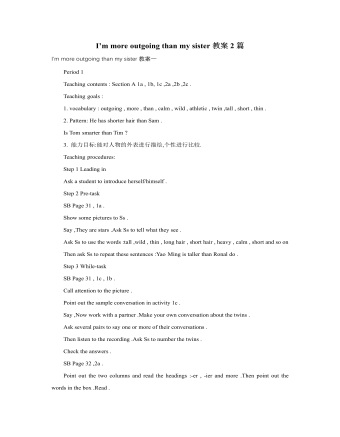
人教版新目标初中英语八年级上册I’m more outgoing than my sister教案2篇
1 交通工具的比较此活动为小组活动。学生通过讨论找出到达某一城市可乘坐的各种交通工具,并选择最佳出行方式。Teacher:We’re going to Shanghai. How many ways can we use to get there? Yes, there are four ways: by bus, by plane, by train, by ship. Please discuss how you are going to get there.操作建议:(1)学生以小组为单位展开活动,谈论本组所选择的交通工具。(2)各组选代表向全班汇报,阐述本组所选择的交通工具的利和弊。完成任务所需要的语言结构:We can go there by ship. It’s more comfortable and cheaper than any other transportation.We can go there by bus. It’s cheaper but it takes longer time.2 哪个城市更合适?此活动具有挑战性。假设中国要举行2014年世界杯足球赛,分别从历史,人文,天气等方面对各城市(北京,大连,上海,昆明)进行比较,选择最佳举办城市。T: Imagine China is holding the 2014 FIFA World Cup. Which city do you think is the best for the World Cup, Beijing, Dalian, Shanghai or Kunming? Let’s work in groups. If you choose Beijing, please join the Team Red. If you chose Dalian, please join the Team White. If you choose Shanghai, please join the Team Blue. If you choose Kunming, please join the Team Green. Please show us its advantages. Then let’s see which team will win.
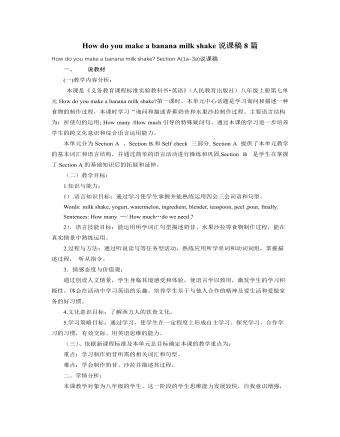
人教版新目标初中英语八年级上册How do you make a banana milk shake说课稿8篇
(五)教学过程1)在课的开始检查学生对单词短语的掌握2)1b,听力为了让学生了解香蕉奶的制作过程,让学生复述,是为了然他们用所学的重点 词汇进行练习、为后面制作水果沙拉奠定基础。3)2a2b的听力是为了复习how much 与how many的区别 ,因为七年级上册unit8涉及到的知识,所以2a2b训练的的真正目的是为了让学生更清楚的了解不可数名词的表达方式 :数词+量词 +of+不可数名词4)在学生完全弄懂事物的制作过程极其不可数名词的数量表达后,我安排他们进行制作水果沙拉的对话。这个对话是机动的,如果时间充足,我让他们按照自己的医院去选择材料进行对话的编排。这个话题既可以用到本科的重点句型,又可用到重点词汇。在这步抓住重点突出难点5)在consolidate 环节,我安排2个汉译英,4个有关how much/how many 的选择,让学生讲做题原因,让他们彻底弄懂不可数名词的数量表达。6)最后,为了加深学生对食物制作过程描述的巩固,让学生把所学知识从口落实到笔头
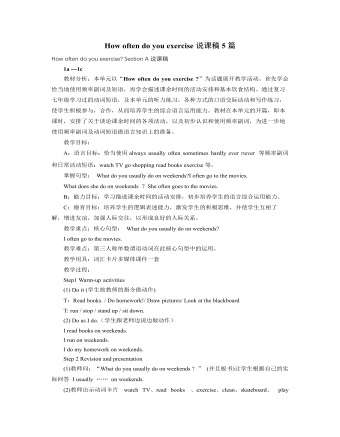
人教版新目标初中英语八年级上册How often do you exercise说课稿5篇
1a ---1c教材分析:本单元以“How often do you exercise ?”为话题展开教学活动。首先学会恰当地使用频率副词及短语,再学会描述课余时间的活动安排和基本饮食结构。通过复习七年级学习过的动词短语,及本单元的听力练习,各种方式的口语交际活动和写作练习,使学生积极参与,合作,从而培养学生的综合语言运用能力。教材在本单元的开篇,即本课时,安排了关于谈论课余时间的各项活动,以及初步认识和使用频率副词,为进一步地使用频率副词及动词短语做语言知识上的准备。教学目标:A:语言目标:恰当使用always usually often sometimes hardly ever never 等频率副词和日常活动短语:watch TV go shopping read books exercise等。掌握句型: What do you usually do on weekends?I often go to the movies.What does she do on weekends ?She often goes to the movies.B:能力目标:学习描述课余时间的活动安排,初步培养学生的语言综合运用能力。C:德育目标:培养学生的逻辑表述能力,激发学生的积极思维,并使学生互相了解,增进友谊,加强人际交往,以形成良好的人际关系。
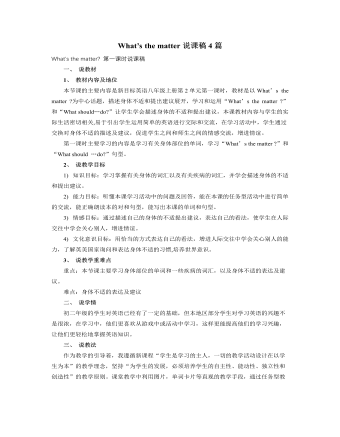
人教版新目标初中英语八年级上册What’s the matter说课稿4篇
在任务环活动中,我通过设计不同的四个任务,让学生在小组中交流、合作、竞争,每个任务都存在着一定的“信息差”,易于激发学生的表达欲望和急于知道最终结果的心情,在活动中他们一定会努力表现自己,做到最好。四个任务所侧重的训练学生的语言能力的要求也各有不同,他们分别侧重训练学生的听、说、读、写的能力。把任务活动放在小组中进行,还可以解决“大班”难于操练的难题,学生在小组中有更多的时间来运用英语表达自己的思想。Post-task任务后活动(4”)1. Grammar Focus(2”)Go through the Grammar Focus with the whole class,ask Ss to point out the main points in this period. Then show the use of The Past Tense on the screen, especially the regular and irregular changes of verbs. 2. Language practice(2”)Practise the sentence patterns and the use of the Past Tense, especially the errors which Ss made while carrying out their tasks. Such as Subject-verb agreement or Tense-agreement, etc. For example: were you see any sharks? He go to the beach. 在学生尽情地参与活动后再让学生反思本节课的语法焦点,并进行适当的操练,对学生在任务活动中的语言失误进行纠正,使学生保持学习信心。语法讲解采用动画形式又保持了学生的学习兴趣。
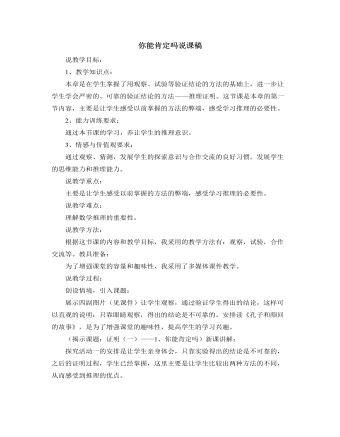
北师大版初中八年级数学上册你能肯定吗说课稿
探究活动二的安排,是要让学生明确只靠实验得出的结论,可能会以点带面,从而进一步说明学习推理的必要性。并小结出:如果要判断一个结论不正确只要举一个反例就可以了。探究活动三的安排是说明只靠实验得出的结论也不可靠,必须经过有根有据的推理才行。活动交流:(1)在数学学习中,你用到过推理吗?(2)在日常生活中,你用到过推理吗?这是一座桥梁,把课堂引向推理的方法。例题的安排,可以让学生学会简单的推理方法,同时增强学生的学习兴趣。课堂练习:①游戏:苹果在哪里?②判断:是谁打破玻璃?把练习变成游戏的形式,也是为了增加课堂的趣味性,提高学生的学习兴趣。课堂小结:进一步明确学习推理的必要性。课后作业:①课本习题6.1:2,3。②预习下一节:定义与命题

北师大版初中八年级数学上册确定一次函数表达式说课稿
③如果某人本月缴所得税19.2元,那么此人本月工资薪金是多少元?根据所给条件写出简单的一次函数表达式是本节课的重点加难点,所以在解决这一问题时及时引导学生总结学习体会,教给学生掌握“从特殊到一般”的认识规律中发现问题的方法。类比出一次函数关系式的一般式的求法,以此突破教学难点。在学习过程中,我巡视并予以个别指导,关注学生的个体发展。经学生分析:(1)当月收入大于1600元而小于2100元时,y=0.05×(x-1600);(2)当x=1760时,y=0.05×(1760-1600)=8(元);(3)设此人本月工资、薪金是x元,则19.2=0.05×(x-1600) X=1984五.教学效果课前:通过本节课的学习,教学目标应该可以基本达成,学生能够理解一次函数和正比例函数的概念,以及它们之间的关系,并能正确识别一次函数解析式,能根据所给条件写出简单的一次函数表达式,且通过本节课的学习学生的抽象思维能力,数学应用能力都能有所提升,
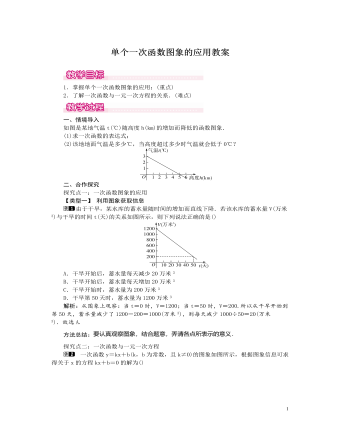
北师大初中数学八年级上册单个一次函数图象的应用1教案
方法总结:要认真观察图象,结合题意,弄清各点所表示的意义.探究点二:一次函数与一元一次方程一次函数y=kx+b(k,b为常数,且k≠0)的图象如图所示,根据图象信息可求得关于x的方程kx+b=0的解为()A.x=-1B.x=2C.x=0D.x=3解析:首先由函数经过点(0,1)可得b=1,再将点(2,3)代入y=kx+1,可求出k的值为1,从而可得出一次函数的表达式为y=x+1,再求出方程x+1=0的解为x=-1,故选A.方法总结:此题主要考查了一次函数与一元一次方程的关系,关键是正确利用待定系数法求出一次函数的关系式.三、板书设计一次函数的应用单个一次函数图象的应用一次函数与一元一次方程的关系探究的过程由浅入深,并利用了丰富的实际情景,增加了学生的学习兴趣.教学中要注意层层递进,逐步让学生掌握求一次函数与一元一次方程的关系.教学中还应注意尊重学生的个体差异,使每个学生都学有所获.
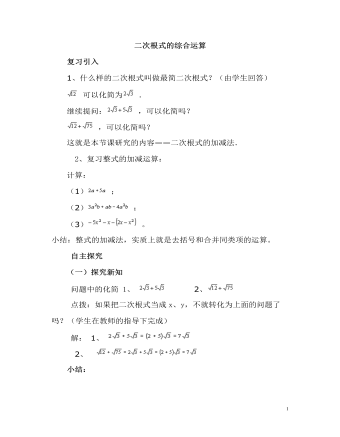
北师大初中数学八年级上册二次根式的混合运算2教案
本节课开始时,首先由一个要在一块长方形木板上截出两块面积不等的正方形,引导学生得出两个二次根式求和的运算。从而提出问题:如何进行二次根式的加减运算?这样通过问题指向本课研究的重点,激发学生的学习兴趣和强烈的求知欲望。本节课是二次根式加减法,目的是探索二次根式加减法运算法则,在设计本课时教案时,着重从以下几点考虑:1.先通过对实际问题的解决来引入二次根式的加减运算,再由学生自主讨论并总结二次根式的加减运算法则。2.四人小组探索、发现、解决问题,培养学生用数学方法解决实际问题的能力。3.对法则的教学与整式的加减比较学习。在理解、掌握和运用二次根式的加减法运算法则的学习过程中,渗透了分析、概括、类比等数学思想方法,提高学生的思维品质和兴趣。
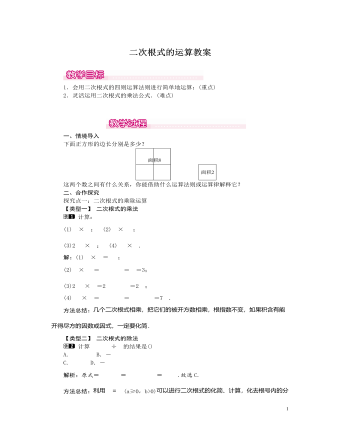
北师大初中数学八年级上册二次根式的运算1教案
1.会用二次根式的四则运算法则进行简单地运算;(重点)2.灵活运用二次根式的乘法公式.(难点)一、情境导入下面正方形的边长分别是多少?这两个数之间有什么关系,你能借助什么运算法则或运算律解释它?二、合作探究探究点一:二次根式的乘除运算【类型一】 二次根式的乘法计算:(1)3×5; (2)13×27;(3)2xy×1x; (4)14×7.解:(1)3×5=15;(2)13×27=13×27=9=3;(3)2xy×1x=2xy×1x=2y;(4)14×7=14×7=72×2=72.方法总结:几个二次根式相乘,把它们的被开方数相乘,根指数不变,如果积含有能开得尽方的因数或因式,一定要化简.【类型二】 二次根式的除法计算a2-2a÷a的结果是()A.-a-2 B.--a-2C.a-2 D.-a-2解析:原式=a2-2aa=a(a-2)a=a-2.故选C.
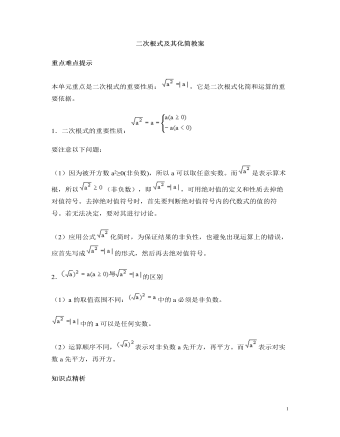
北师大初中数学八年级上册二次根式及其化简2教案
属于此类问题一般有以下三种情况①具体数字,此时化简的条件已暗中给定,②恒为非负值或根据题中的隐含条件,如(1)小题。③给出明确的条件,如(2)小题。第二类,需讨论后再化简。当题目中给定的条件不能判定绝对值符号内代数式值的符号时,则需讨论后化简,如(4)小题。例3.已知a+b=-6,ab=5,求 的值。解:∵ab=5>0,∴a,b同号,又∵a+b=-6<0,∴a<0,b<0∴ .说明:此题中的隐含条件a<0,b<0不能忽视。否则会出现错误。例4.化简: 解:原式=|x-6|-|1+2x|+|x+5|令x-6=0,得x=6,令1+2x=0,得 ,令x+5=0,得x=-5.这样x=6, ,x=-5,把数轴分成四段(四个区间)在这五段里分别讨论如下:当x≥6时,原式=(x-6)-(1+2x)+(x+5)=-2.当 时,原式=-(x-6)-(1+2x)+(x+5)=-2x+10.当 时,原式=-(x-6)-[-(1+2x)]+(x+5)=2x+12.当x<-5时,原式=-(x-6)+(1+2x)-(x+5)=2.说明:利用公式 ,如果绝对值符号里面的代数式的值的符号无法决定,则需要讨论。方法是:令每一个绝对值内的代数式为零,求出对应的“零点”,再用这些“零点”把数轴分成若干个区间,再在每个区间内进行化简。
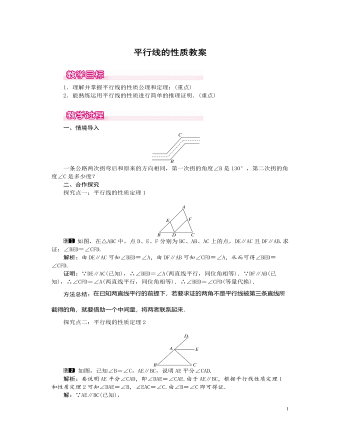
北师大初中数学八年级上册平行线的性质1教案
方法总结:平行线与角的大小关系、直线的位置关系是紧密联系在一起的.由两直线平行的位置关系得到两个相关角的数量关系,从而得到相应角的度数.探究点四:平行于同一条直线的两直线平行如图所示,AB∥CD.求证:∠B+∠BED+∠D=360°.解析:证明本题的关键是如何使平行线与要证的角发生联系,显然需作出辅助线,沟通已知和结论.已知AB∥CD,但没有一条直线既与AB相交,又与CD相交,所以需要作辅助线构造同位角、内错角或同旁内角,但是又要保证原有条件和结论的完整性,所以需要过点E作AB的平行线.证明:如图所示,过点E作EF∥AB,则有∠B+∠BEF=180°(两直线平行,同旁内角互补).又∵AB∥CD(已知),∴EF∥CD(如果两条直线都和第三条直线平行,那么这两条直线也互相平行),∴∠FED+∠D=180°(两直线平行,同旁内角互补).∴∠B+∠BEF+∠FED+∠D=180°+180°(等式的性质),即∠B+∠BED+∠D=360°.方法总结:过一点作一条直线或线段的平行线是我们常作的辅助线.
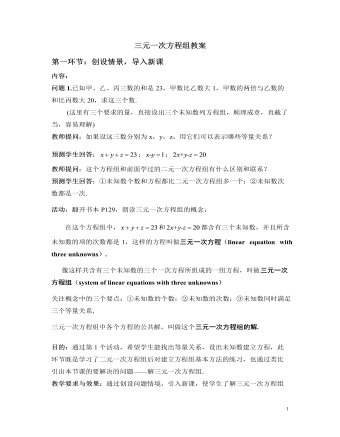
北师大初中数学八年级上册三元一次方程组2教案
目的:课后作业设计包括了两个层面:作业1是为了巩固基础知识而设计;作业2是为了扩展学生的知识面;拓广知识,增加学生对数学问题本质的思考而设计,通过此题可让学生进一步运用三元一次方程组解决问题.教学设计反思1.本节课的内容属于选修学习的内容,主要突出对数学兴趣浓厚、学有余力的同学进一步探究和拓展使用,在数学方法和思想方面需重点引导,通过引导,使学生明白解多元方程组的一般方法和思想,理解巩固环节需多注意多种解题方法的引导,并且比较各种解题方法之间的优劣,总结出解多元方程的基本方法.2.作为选修课,在内容上要让学生理解三元一次方程组概念的同时,要让学生理解为什么要用三元一次方程组甚至多元方程组去求解实际问题的必要性,从而掌握本堂课的基础知识.在教学的过程中,要让学生充分理解对复杂的实际问题方程中元越多,等量关系的建立就越直接;充分理解代入消元法和加减法解方程的优点和缺点,有关这一方面的题目要让学生充分讨论、交流、合作,其理解才会深刻.
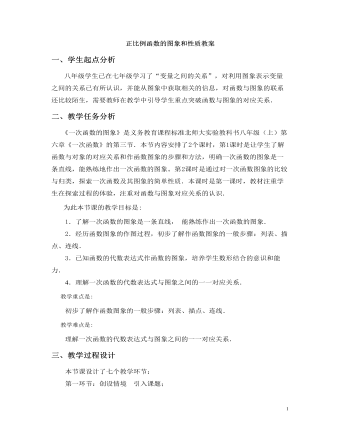
北师大初中数学八年级上册正比例函数的图象和性质2教案
四、教学设计反思这节内容是学生利用数形结合的思想去研究正比例函数的图象,对函数与图象的对应关系有点陌生.在教学过程中教师应通过情境创设激发学生的学习兴趣,对函数与图象的对应关系应让学生动手去实践,去发现,对正比例函数的图象是一条直线应让学生自己得出.在得出结论之后,让学生能运用“两点确定一条直线”,很快作出正比例函数的图象.在巩固练习活动中,鼓励学生积极思考,提高学生解决实际问题的能力.当然,根据学生状况,教学设计也应做出相应的调整。如第一环节:创设情境 引入课题,固然可以激发学生兴趣,但也可能容易让学生关注代数表达式的寻求,甚至对部分学生形成一定的认知障碍,因此该环节也可以直接开门见山,直入主题,如提出问题:正比例函数的代数形式是y=kx,那么,一个正比例函数对应的图形具有什么特征呢?

人教部编版语文八年级上册课外古诗词诵读教案
三、品读,感悟词人情怀1.品读“醉”意设问1:再次默读词作。想一想:这首词是围绕哪一个字来写的?从哪些地方可以看出来?预设 “醉”字。表现:沉醉不知归路;误入藕花深处。设问2:词人因何而“醉”?预设 因美酒和美景而“醉”。设问3:除了美景、美酒,还有什么会让李清照“醉”?预设 还有词人和自己的伙伴在一起的那种美好情谊,对年轻时那些美好生活的回忆,都让她深深陶醉。师小结:李清照的“醉”既是酒醉更是陶醉。其实不管“兴”也好,“记”也罢,“醉”也好,还是“误”也好,作者是“字字如金”。因为“兴”所以“醉”,因为“醉”所以“误”,因为“醉”,所以常常记得。2.品字悟情设问1:如何理解两个“争渡”表达出的情感?预设 两个“争渡”,表现了主人公急于从迷途中找寻出路的焦灼心情。正是由于“争渡”,所以又“惊起一滩鸥鹭”,把停栖在沙洲上的水鸟都吓飞了。至此,词戛然而止,言尽而意未尽,耐人寻味。
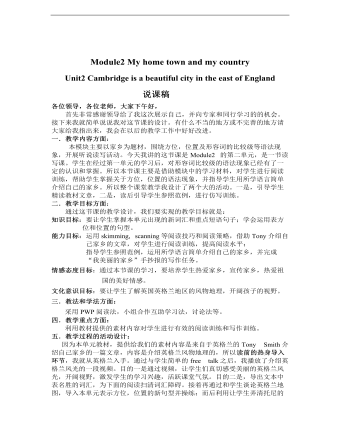
初中英语外研版八年级上册《Module 2 My home town and my countryUnit 2》说课稿
一.教学内容方面:本模块主要以家乡为题材,围绕方位,位置及形容词的比较级等语法现象,开展听说读写活动。今天我讲的这节课是Module2 的第二单元,是一节读写课。学生在经过第一单元的学习后,对形容词比较级的语法现象已经有了一定的认识和掌握。所以本节课主要是借助模块中的学习材料,对学生进行阅读训练,帮助学生掌握关于方位,位置的语法现象,并指导学生用所学语言简单介绍自己的家乡。所以整个课堂教学我设计了两个大的活动。一是,引导学生精读教材文章,二是,读后引导学生参照范例,进行仿写训练。
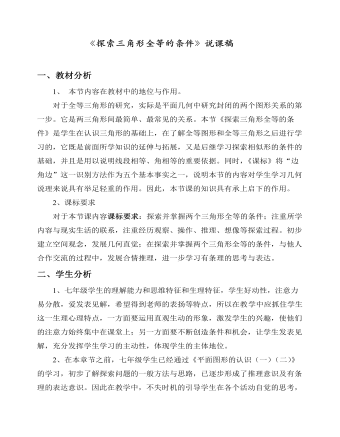
初中数学苏科版八年级上册《探索三角形全等的条件12》说课稿
2、课标要求对于本节课内容课标要求:探索并掌握两个三角形全等的条件;注重所学内容与现实生活的联系,注重经历观察、操作、推理、想像等探索过程。初步建立空间观念,发展几何直觉;在探索并掌握两个三角形全等的条件,与他人合作交流的过程中,发展合情推理,进一步学习有条理的思考与表达。二、学生分析 1、七年级学生的理解能力和思维特征和生理特征,学生好动性,注意力易分散,爱发表见解,希望得到老师的表扬等特点,所以在教学中应抓住学生这一生理心理特点,一方面要运用直观生动的形象,激发学生的兴趣,使他们的注意力始终集中在课堂上;另一方面要不断创造条件和机会,让学生发表见解,充分发挥学生学习的主动性,体现学生的主体地位。
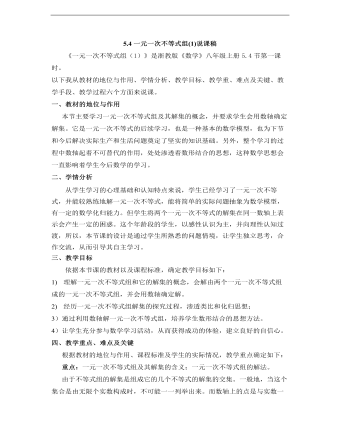
初中数学浙教版八年级上册《54一元一次不等式组(1)》说课稿
一、教材的地位与作用 本节主要学习一元一次不等式组及其解集的概念,并要求学生会用数轴确定解集。它是一元一次不等式的后续学习,也是一种基本的数学模型,也为下节和今后解决实际生产和生活问题奠定了坚实的知识基础。另外,整个学习的过程中数轴起着不可替代的作用,处处渗透着数形结合的思想,这种数学思想会一直影响着学生今后数学的学习。二、学情分析从学生学习的心理基础和认知特点来说,学生已经学习了一元一次不等式,并能较熟练地解一元一次不等式,能将简单的实际问题抽象为数学模型,有一定的数学化归能力。但学生将两个一元一次不等式的解集在同一数轴上表示会产生一定的困惑。这个年龄段的学生,以感性认识为主,并向理性认知过渡,所以,本节课的设计是通过学生所熟悉的问题情境,让学生独立思考,合作交流,从而引导其自主学习。
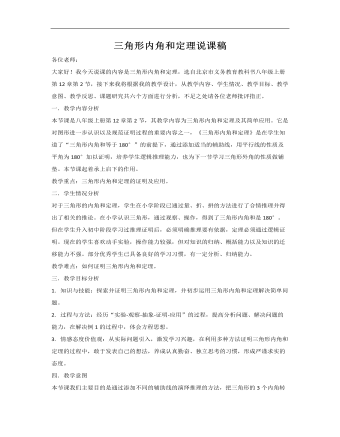
初中数学北京课改版八年级上册《122三角形的性质》说课稿
一.学生情况分析对于三角形的内角和定理,学生在小学阶段已通过量、折、拼的方法进行了合情推理并得出了相关的推论。在小学认识三角形,通过观察、操作,得到了三角形内角和是180°。但在学生升入初中阶段学习过推理证明后,必须明确推理要有依据,定理必须通过逻辑证明。现在的学生喜欢动手实验,操作能力较强,但对知识的归纳、概括能力以及知识的迁移能力不强。部分优秀学生已具备良好的学习习惯,有一定分析、归纳能力。
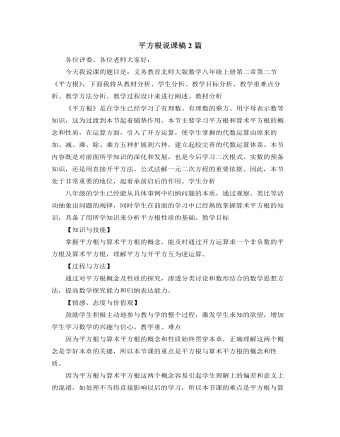
北师大版初中八年级数学上册平方根说课稿2篇
让学生先独立解决⑴题,再小组交流⑵题的答案,找到解题的方法.2、例2,例3是对平方根概念的巩固与拓展,在例2中由于学生还不熟于平方根的表示方法,所以应在平方根的概念和±号上加以明确,而例3则要把握平方根概念的本质,根据该数的正负或0来确定其平方根,这部分内容可用板演或展台展示结果的方式进行,让学生独立完成,应给予恰当的评价.3、最后,我又设计了一道辨析题:在做一道求4的平方根的题目时,小明说:“4的平方根是2”,小红说:“4的平方根是-2”,小强说:“2是4的平方根”小芳说:“-2是4的平方根”,请问他们的说法正确吗?通过这道题目,使学生在熟悉平方根概念的基础上更加深理解,同时对以往五种运算中从未出现过的一题两解的现象作出了解释,使学生明白了一种整体与局部的关系,再一次突出了重点.





















